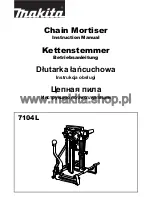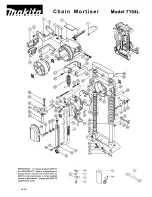
73
GB
11.1.2 Overload protection
In the event of overloading, the motor will switch itself off. After
a cool-down period (time varies) the motor can be switched
back on again.
1. Allow the product to cool.
2. Press the overload switch (15).
3. Switch on the machine as described in 11.1.1.
11.1.3 Speed selection switch
The saw has 2 speed ranges:
• To saw with low speed, push the “3200 RPM” button (low
speed switch 10b) at the speed selection switch (10).
• To saw with high speed (wood), push the “5000 RPM” but-
ton (high speed switch 10a) at the speed selection switch
(10).
11.2 Setting the cutting depth (fig. 1)
The saw blade (6) can be adjusted to the required cutting
depth by turning the crank wheel (14).
• Counterclockwise: Greater cutting depth
• Clockwise: Smaller cutting depth
Check the setting with a test cut.
11.3 Setting the cutting angle (fig. 1, 16)
With the circular table saw, angled cuts from 0 ° to 45 ° to the
left of the parallel stop (1) can be carried out.
m
Before each cut, check that no collision can occur between
the parallel stop (1), the transverse stop (3) and the saw blade
(6).
1. Loosen the locking lever (13).
2. Set the desired angle on the scale (12) by simultaneously
pushing in and turning the crank wheel (14).
3. Lock the locking lever (13) at the desired angle setting.
For special mitre cuts (undercut), the tilt angle (to the right) can
be increased by 2 °:
1. Loosen the locking lever (13).
2. Turn the saw unit a quarter turn away from the stop 0°
by simultaneously pushing in and turning the crank wheel
(14).
3. Press and hold down the tilt limiter (11).
4. Set the saw blade angle in the range from 0 to −2 °.
5. Release the tilt limiter (11) again and lock the locking lever
(13) at the desired angle setting.
11.4 Using the parallel stop
11.4.1 Stop heights (fig. 17)
• The stop rail (1a) of the parallel stop (1) has two guide sur-
faces at different heights.
• Depending on the thickness of the material to be cut, the stop
rail (1a) must be used for thick material (workpiece thickness
exceeding 25 mm) and for thin material (workpiece thick-
ness below 25 mm).
11.4.2 Setting the stop rail (fig. 17)
1. To move the stop rail (1a) to the lower guide surface, loosen
the two knurled nuts (1b) to release the stop rail (1a) from
parallel stop (1).
2. Pull out the stop rail (1a) along the groove.
3. Turn the stop rail (1a) and slide the sliding block along the
second groove.
4. Shifting to the higher guide surface must be carried out in
the same way.
11.4.3 Changing the side of the parallel stop
1. Fully unscrew the knurled nuts (1b).
2. Remove the stop rail (1a) and insert the coach bolts (1c) on
the opposite side of the parallel stop (1).
11.4.4 Setting the cutting width (fig. 11)
• The parallel stop (1) must be used when cutting sections of
wood lengthways.
• The parallel stop (1) can be mounted on both sides of the
saw table (2).
• Two scales are printed on the guide rail (20) on the front side
of the saw table (2). One written in red and another one in
black indicating the distance between stop rail (1a) and saw
blade (6) (cutting width):
-
Use the upper scale in black, if you have mounted the
stop rail (1a) flat (for thin material).
-
Use the lower scale in red, if you have mounted the stop
rail (1a) upright (for thick material).
To set the parallel stop (1) to the desired dimension, proceed
as follows:
1. Raise the eccentric lever (27).
2. Slide the parallel stop (1) until you see the desired dimen-
sion on the scale of the guide rail (20) in the sight glass
(30).
3. To fix it in place, press the eccentric lever (27) fully down-
wards.
11.4.5 Setting the stop length (fig. 18)
To avoid the material to be cut becoming jammed, the stop rail
(1a) can slide in a longitudinal direction.
Rule of thumb: The rear edge of the stop should intersect an
imaginary line that starts roughly at the centre of the saw blade
and runs to the rear at 45 °.
1. Set the required cutting width.
2. Loosen the knurled nuts (1b).
3. Slide the stop rail (1a) far enough forward that it touches
the imaginary 45 ° line.
4. Tighten the knurled nuts (1b) again.
Содержание PTKS 2000 F4
Страница 87: ......










































